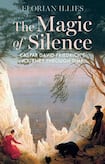
“Rückenfigur” describes an artist showing a figure from behind. Back in the German Romantic period of the late-18th and early-19th centuries, Caspar David Friedrich was your rückenfigur go-to. In his most famous work, Wanderer Above the Sea of Fog (1818), a solitary man stands on a crag, with a seemingly God’s-eye view above the clouds. It invites ideas of mystery and intrigue, and allows us to read ourselves into the scene. According to Florian Illies, Friedrich mainly used it because he wasn’t very good at faces.
Originally published in German in 2023, Illies’s The Magic of Silence is an intriguing take on the life and work of the German painter (born in what was then Swedish Pomerania), and it is initially disconcerting. Opening with a prologue set in the year Wanderer was painted, we are immediately with Friedrich and his new wife, Caroline, on a romantic sailboat jaunt, privy to their musings. I am always dismayed by biographers who tell us what their subjects thought. How do we know his smile was shy? How do we know he smiled at all?
Read on. This is not a biography, this is the kind of art book to which all art books should perhaps aspire. Organised under elemental sections – fire, water, earth, air – instead of the more usual birth, school, marriage, death, Illies dances back and forth through time. We meet multihyphenated European nobility buying Friedrichs for their castles, modern international art thieves, and countless paintings lost in war.
As an art historian, Illies has a vast depth of knowledge; as a writer, he has a lightness of touch and a useful sense of the ridiculous. Time comes to life across the eras. Friedrich inspired Walt Disney to create Bambi, Hitler loved him, Stalin loathed him, Sam Beckett credited him with Godot. He has been forgotten, rediscovered, misunderstood and reinterpreted. And that’s the point, and the true beauty of this book. Art does not petrify in the time of the artist, it changes and does not rest, even when fixed to a museum wall.
READ MORE
A work of art comes to life anew each time we choose to look at it, and each time it is full of our own endless potential. Illies quotes philosopher Ernst Bloch, on a trio of Friedrich’s more depressing paintings: “the fact that someone survived to paint the picture, and another person to look at it, shows that all was not lost.” Read and hope.














